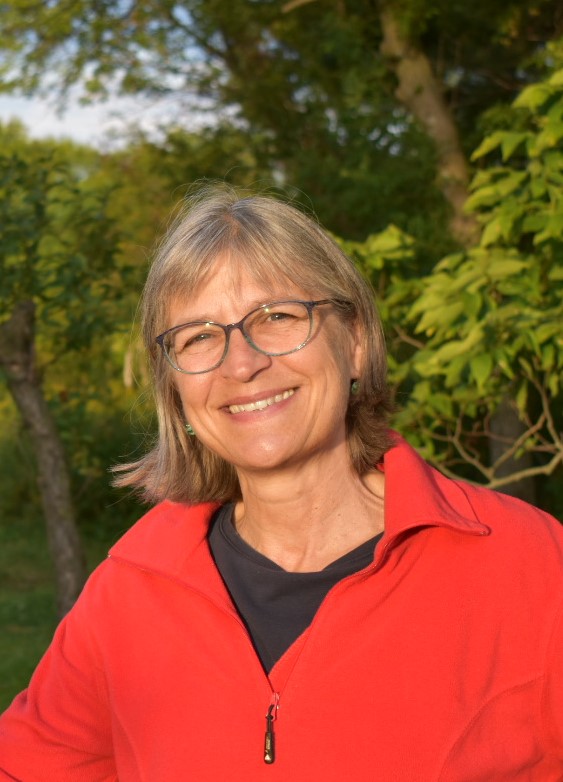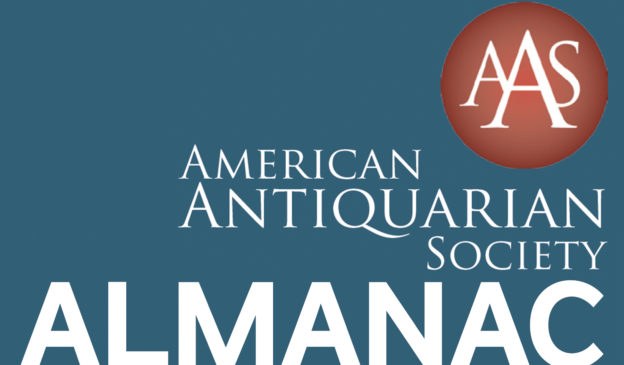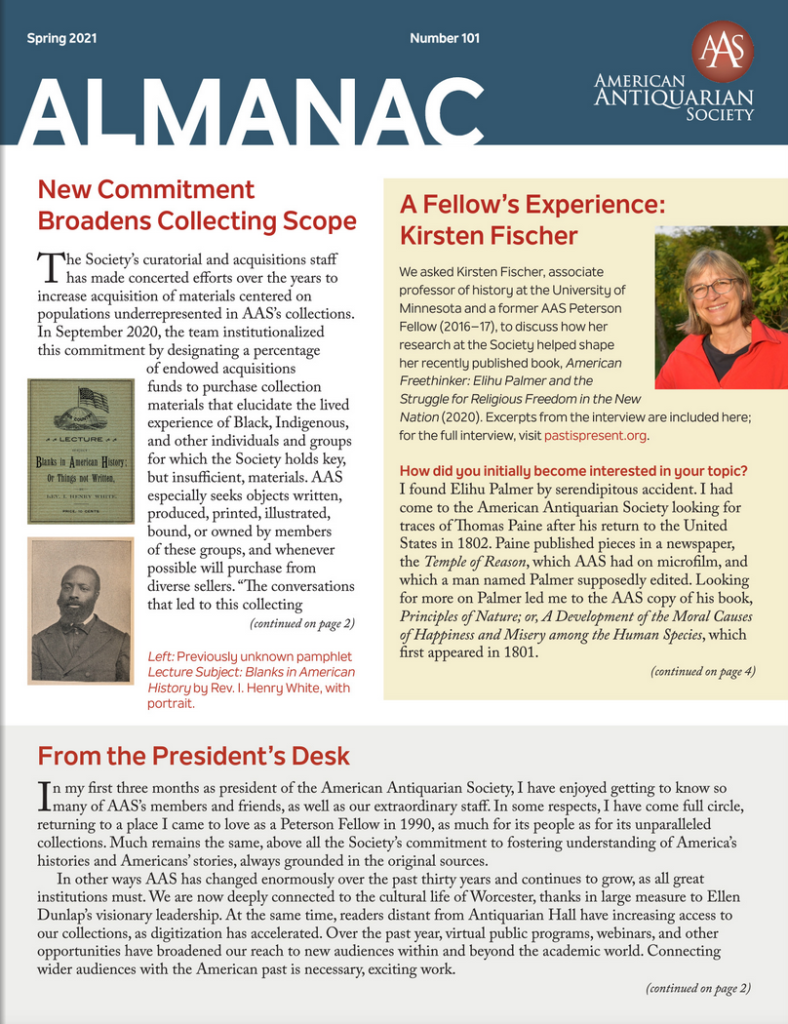A Fellow’s Experience: Kirsten Fischer
 We asked Kirsten Fischer, associate professor of history at the University of Minnesota and a former AAS Peterson Fellow (2016 –17), to discuss how her research at the Society helped shape her recently published book, American Freethinker: Elihu Palmer and the Struggle for Religious Freedom in the New Nation (2020).
We asked Kirsten Fischer, associate professor of history at the University of Minnesota and a former AAS Peterson Fellow (2016 –17), to discuss how her research at the Society helped shape her recently published book, American Freethinker: Elihu Palmer and the Struggle for Religious Freedom in the New Nation (2020).
How did you initially become interested in your topic?
I found Elihu Palmer by serendipitous accident. I had come to the American Antiquarian Society looking for traces of Thomas Paine after his return to the United States in 1802. Paine published pieces in a newspaper, the Temple of Reason, which AAS had on microfilm, and which a man named Palmer supposedly edited. Looking for more on Palmer led me to the AAS copy of his book, Principles of Nature; or, A Development of the Moral Causes of Happiness and Misery Among the Human Species, which first appeared in 1801.
The book was strange and confusing. Palmer kept insisting on a unified material world infused with a life force, and he was sure these “principles of nature” mattered enormously for human happiness. He argued with passion, but his ideas of vibrant matter made only partial sense to me. Only when I read the works of the obscure authors he quoted at length, did I begin to understand that Palmer had been influenced by vitalist physiology coming out of medical circles in Europe, and also by Eastern religions as represented to him by a world-traveling Englishman. John “Walking” Stewart had traveled to India and Thailand, and he shared with Palmer the power of meditation to grasp the unified whole of the universe. Stewart persuaded Palmer that the smallest particles of matter are sensate, meaning they experience and retain sensations like pleasure and pain. These particles are constantly in motion, and as they jump from one thing to the next, they carry sensation with them. This idea changed everything, Palmer thought, because it meant that in the interconnected web of life, every individual action affects the whole. I found the idea fascinating—somehow ancient and modern at the same time—and a challenge to commonplace notions of who and what merits compassion and respect.
 How did coming across Palmer’s book lead to you writing his biography?
How did coming across Palmer’s book lead to you writing his biography?
At first, I thought I could write only about Palmer’s ideas, not the man himself, because Palmer left very little in terms of a personal archive, really just a few letters. We did not even know the name of his hometown in Connecticut. Then it occurred to me to look in the archives of people who might have known him, for example ministers who denounced him as a dangerous heretic. In Connecticut I used lists of names engraved on headstones to search for Palmer families buried in small-town cemeteries. Once I found his family headstones, I could use local church and land records to fill in blanks about Palmer’s family and his upbringing. To my immense good fortune, I even found the manuscript diary kept by Palmer’s childhood minister. Newspaper advertisements for his lectures and attacks printed by his enemies helped me track Palmer’s movements and his rising fame. Putting together the many tiny pieces, I was able to write a new biography of this colorful figure in the early Republic. And he was a character. Although Palmer lost his eyesight when he was twenty-nine, he continued to travel and lecture in the company of other freethinkers. His speeches and publications challenged conventional limits on freedom of religion and of speech, and by 1802, his enemies denounced him as a danger to the nation.
How did your fellowship experience at AAS influence your work?
I had come to AAS on my own dime several times, always for just a few days. My month-long fellowship in 2016 enabled me to look further afield for signs of Palmer. On my very first day as a fellow, I requested the recently published diary of a young physician whose manuscript is held at Columbia University. In volume one of Alexander Anderson’s New York City Diary, 1793 to 1799, edited by Jane R. Pomeroy (Oak Knoll Press and AAS, 2014), I found evidence for something I had suspected but did not think I would be able to prove: the personal friendship between Palmer and his mentor, John Stewart. Dr. Anderson witnessed Palmer and Stewart walking arm-in-arm into a New York bookstore, cracking jokes and laughing. Thank you, Alexander Anderson, for thinking to note this in your journal; thank you, Jane Pomeroy, for transcribing the diary; thank you, AAS, for publishing it! I already knew Palmer thought highly of Stewart’s ideas; now I knew their relationship was personal.
Serendipitous finds like this occur when one has time to look beyond the immediately obvious entries in the catalog to snoop around in places where one might find something. The best finds of my book came about because fellowships gave me the time to fall into archival rabbit holes, some of which hold real treasure. Also very special to me was staying in the Reese House with other scholars in residence, giving presentations on our projects, and informally sharing our finds after a day in the archive. The staff at AAS is magnificent, and I continued to get help with items and images even after my fellowship had ended.
How might Elihu Palmer’s story resonate for today’s readers?
In writing the book, I came to understand that the new United States was born with divergent impulses. Religious pluralism flourished, but so too did anxiety about the public expression of that diversity. We see some of these tensions still today. The ability to accept, never mind welcome, religious diversity remains a challenge for many, even as the country is irrepressibly diverse. Americans continue to accuse one another of harboring religious beliefs incompatible with patriotism. Palmer’s life story shows how religious freethought developed in tandem with the efforts to contain it. The struggle persists, it waxes and wanes, and it might be with us for a long time.
Palmer reached for creative answers to pressing concerns, such as how to achieve social justice without incurring violence, how to have a shared morality without relying on a shared religion, and how to protect interdependent life on planet Earth. These issues remain relevant today. In a world riven by inequality, political disagreement, racialized violence, and climate change, we need to find common ground amidst our differences. Palmer banked on a transformative psychology, one based on the recognition of a shared fate in an interconnected web of life. His answers may not be ours, but he was asking questions that still await creative solutions, and he did it with a passion and an optimism I find inspiring.
What are you currently working on?
My next project is a hybrid of archivally researched family history and memoir. Three generations of my father’s German family experienced displacement due to two world wars and then the country’s political division. I explore what they experienced and how their stories have shaped my own sense of belonging and home. I’m learning how to write in a more personal and—dare I say it?—literary manner, and I’ve been studying twentieth-century German history, historical memory, and how memoir can serve as a lens onto the past. It’s very engaging work.
This interview is featured in the latest issue of the AAS publication The Almanac. Please follow the link to read the entire issue and learn more about recent events and news at the Society.


